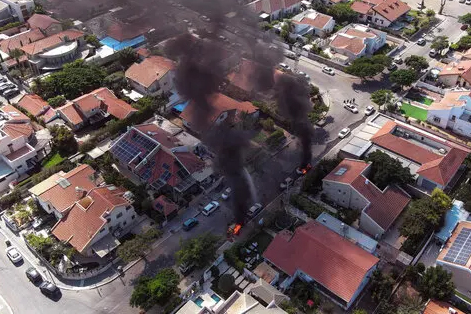|
|
|
|
|
|
 |
|
|
Hamas-led
gunmen
seized
an
Israeli
military
vehicle
after
infiltrating
areas of
southern
Israel
during
the Oct.
7
attacks.
A
blueprint
for
similar
attacks
was
circulating
among
Israeli
leaders
long
before
Hamas
struck.Credit...Ahmed
Zakot/Reuters |
| |
Israel
Knew
Hamas’s
Attack
Plan
Over a
Year Ago
By Ronen
Bergman,
and Adam
Goldman
nytimes.com
TEL
AVIV, -
Israeli
officials
obtained
Hamas’s
battle
plan for
the Oct.
7
terrorist
attack
more
than a
year
before
it
happened,
documents,
emails
and
interviews
show.
But
Israeli
military
and
intelligence
officials
dismissed
the plan
as
aspirational,
considering
it too
difficult
for
Hamas to
carry
out.
The
approximately
40-page
document,
which
the
Israeli
authorities
code-named
“Jericho
Wall,”
outlined,
point by
point,
exactly
the kind
of
devastating
invasion
that led
to the
deaths
of about
1,200
people.
The
translated
document,
which
was
reviewed
by The
New York
Times,
did not
set a
date for
the
attack,
but
described
a
methodical
assault
designed
to
overwhelm
the
fortifications
around
the Gaza
Strip,
take
over
Israeli
cities
and
storm
key
military
bases,
including
a
division
headquarters.
Hamas
followed
the
blueprint
with
shocking
precision.
The
document
called
for a
barrage
of
rockets
at the
outset
of the
attack,
drones
to knock
out the
security
cameras
and
automated
machine
guns
along
the
border,
and
gunmen
to pour
into
Israel
en masse
in
paragliders,
on
motorcycles
and on
foot —
all of
which
happened
on Oct.
7.
The plan
also
included
details
about
the
location
and size
of
Israeli
military
forces,
communication
hubs and
other
sensitive
information,
raising
questions
about
how
Hamas
gathered
its
intelligence
and
whether
there
were
leaks
inside
the
Israeli
security
establishment.
The
document
circulated
widely
among
Israeli
military
and
intelligence
leaders,
but
experts
determined
that an
attack
of that
scale
and
ambition
was
beyond
Hamas’s
capabilities,
according
to
documents
and
officials.
It is
unclear
whether
Prime
Minister
Benjamin
Netanyahu
or other
top
political
leaders
saw the
document,
as well.

A woman
running
to the
concrete
shelter
at her
home in
Ashkelon,
Israel,
after a
rocket
siren
sounded
on Oct.
7.Credit...Tamir
Kalifa
for The
New York
Times
Last
year,
shortly
after
the
document
was
obtained,
officials
in the
Israeli
military’s
Gaza
division,
which is
responsible
for
defending
the
border
with
Gaza,
said
that
Hamas’s
intentions
were
unclear.
“It is
not yet
possible
to
determine
whether
the plan
has been
fully
accepted
and how
it will
be
manifested,”
read a
military
assessment
reviewed
by The
Times.
Then, in
July,
just
three
months
before
the
attacks,
a
veteran
analyst
with
Unit
8200,
Israel’s
signals
intelligence
agency,
warned
that
Hamas
had
conducted
an
intense,
daylong
training
exercise
that
appeared
similar
to what
was
outlined
in the
blueprint.
But a
colonel
in the
Gaza
division
brushed
off her
concerns,
according
to
encrypted
emails
viewed
by The
Times.
“I
utterly
refute
that the
scenario
is
imaginary,”
the
analyst
wrote in
the
email
exchanges.
The
Hamas
training
exercise,
she
said,
fully
matched
“the
content
of
Jericho
Wall.”
“It is a
plan
designed
to start
a war,”
she
added.
“It’s
not just
a raid
on a
village.”
Officials
privately
concede
that,
had the
military
taken
these
warnings
seriously
and
redirected
significant
reinforcements
to the
south,
where
Hamas
attacked,
Israel
could
have
blunted
the
attacks
or
possibly
even
prevented
them.

Israeli
soldiers
were
deployed
in an
area
where
civilians
were
killed
in the
southern
city of
Sderot
on Oct.
7.Credit...Oren
Ziv/Agence
France-Presse
— Getty
Images
Instead,
the
Israeli
military
was
unprepared
as
terrorists
streamed
out of
the Gaza
Strip.
It was
the
deadliest
day in
Israel’s
history.
Israeli
security
officials
have
already
acknowledged
that
they
failed
to
protect
the
country,
and the
government
is
expected
to
assemble
a
commission
to study
the
events
leading
up to
the
attacks.
The
Jericho
Wall
document
lays
bare a
yearslong
cascade
of
missteps
that
culminated
in what
officials
now
regard
as the
worst
Israeli
intelligence
failure
since
the
surprise
attack
that led
to the
Arab-Israeli
war of
1973.
Underpinning
all
these
failures
was a
single,
fatally
inaccurate
belief
that
Hamas
lacked
the
capability
to
attack
and
would
not dare
to do
so. That
belief
was so
ingrained
in the
Israeli
government,
officials
said,
that
they
disregarded
growing
evidence
to the
contrary.
The
Israeli
military
and the
Israeli
Security
Agency,
which is
in
charge
of
counterterrorism
in Gaza,
declined
to
comment.
Officials
would
not say
how they
obtained
the
Jericho
Wall
document,
but it
was
among
several
versions
of
attack
plans
collected
over the
years. A
2016
Defense
Ministry
memorandum
viewed
by The
Times,
for
example,
says,
“Hamas
intends
to move
the next
confrontation
into
Israeli
territory.”
Such an
attack
would
most
likely
involve
hostage-taking
and
“occupying
an
Israeli
community
(and
perhaps
even a
number
of
communities),”
the memo
reads.

Vehicles
caught
fire in
Ashkelon,
Israel,
as
rockets
were
launched
from the
Gaza
Strip on
Oct.
7.Credit...Ilan
Rosenberg/Reuters
The
Jericho
Wall
document,
named
for the
ancient
fortifications
in the
modern-day
West
Bank,
was even
more
explicit.
It
detailed
rocket
attacks
to
distract
Israeli
soldiers
and send
them
hurrying
into
bunkers,
and
drones
to
disable
the
elaborate
security
measures
along
the
border
fence
separating
Israel
and
Gaza.
Hamas
fighters
would
then
break
through
60
points
in the
wall,
storming
across
the
border
into
Israel.
The
document
begins
with a
quote
from the
Quran:
“Surprise
them
through
the
gate. If
you do,
you will
certainly
prevail.”
The same
phrase
has been
widely
used by
Hamas in
its
videos
and
statements
since
Oct. 7.
One of
the most
important
objectives
outlined
in the
document
was to
overrun
the
Israeli
military
base in
Re’im,
which is
home to
the Gaza
division
responsible
for
protecting
the
region.
Other
bases
that
fell
under
the
division’s
command
were
also
listed.
Hamas
carried
out that
objective
on Oct.
7,
rampaging
through
Re’im
and
overrunning
parts of
the
base.
The
audacity
of the
blueprint,
officials
said,
made it
easy to
underestimate.
All
militaries
write
plans
that
they
never
use, and
Israeli
officials
assessed
that,
even if
Hamas
invaded,
it might
muster a
force of
a few
dozen,
not the
hundreds
who
ultimately
attacked.
Israel
had also
misread
Hamas’s
actions.
The
group
had
negotiated
for
permits
to allow
Palestinians
to work
in
Israel,
which
Israeli
officials
took as
a sign
that
Hamas
was not
looking
for a
war.
But
Hamas
had been
drafting
attack
plans
for many
years,
and
Israeli
officials
had
gotten
hold of
previous
iterations
of them.
What
could
have
been an
intelligence
coup
turned
into one
of the
worst
miscalculations
in
Israel’s
75-year
history.
Image
A
barefoot
person
lies in
the back
of a
white
Toyota
pickup
as men
surround
it.
A truck
reportedly
transported
a
captured
Israeli
woman in
Khan
Younis,
in the
southern
Gaza
Strip,
on Oct.
7.Credit...Agence
France-Presse
— Getty
Images
A
barefoot
person
lies in
the back
of a
white
Toyota
pickup
as men
surround
it.
In
September
2016,
the
defense
minister’s
office
compiled
a
top-secret
memorandum
based on
a much
earlier
iteration
of a
Hamas
attack
plan.
The
memorandum,
which
was
signed
by the
defense
minister
at the
time,
Avigdor
Lieberman,
said
that an
invasion
and
hostage-taking
would
“lead to
severe
damage
to the
consciousness
and
morale
of the
citizens
of
Israel.”
The
memo,
which
was
viewed
by The
Times,
said
that
Hamas
had
purchased
sophisticated
weapons,
GPS
jammers
and
drones.
It also
said
that
Hamas
had
increased
its
fighting
force to
27,000
people —
having
added
6,000 to
its
ranks in
a
two-year
period.
Hamas
had
hoped to
reach
40,000
by 2020,
the memo
determined.
Last
year,
after
Israel
obtained
the
Jericho
Wall
document,
the
military’s
Gaza
division
drafted
its own
intelligence
assessment
of this
latest
invasion
plan.
Hamas
had
“decided
to plan
a new
raid,
unprecedented
in its
scope,”
analysts
wrote in
the
assessment
reviewed
by The
Times.
It said
that
Hamas
intended
to carry
out a
deception
operation
followed
by a
“large-scale
maneuver”
with the
aim of
overwhelming
the
division.
But the
Gaza
division
referred
to the
plan as
a
“compass.”
In other
words,
the
division
determined
that
Hamas
knew
where it
wanted
to go
but had
not
arrived
there
yet.
On July
6, 2023,
the
veteran
Unit
8200
analyst
wrote to
a group
of other
intelligence
experts
that
dozens
of Hamas
commandos
had
recently
conducted
training
exercises,
with
senior
Hamas
commanders
observing.
The
training
included
a dry
run of
shooting
down
Israeli
aircraft
and
taking
over a
kibbutz
and a
military
training
base,
killing
all the
cadets.
During
the
exercise,
Hamas
fighters
used the
same
phrase
from the
Quran
that
appeared
at the
top of
the
Jericho
Wall
attack
plan,
she
wrote in
the
email
exchanges
viewed
by The
Times.
The
analyst
warned
that the
drill
closely
followed
the
Jericho
Wall
plan,
and that
Hamas
was
building
the
capacity
to carry
it out.
The
colonel
in the
Gaza
division
applauded
the
analysis
but said
the
exercise
was part
of a
“totally
imaginative”
scenario,
not an
indication
of
Hamas’s
ability
to pull
it off.
“In
short,
let’s
wait
patiently,”
the
colonel
wrote.
Image
A
soldier
in a
green
uniform
and
carrying
a rifle
walks
past two
bodies
covered
with
sheets
on the
ground.
An
Israeli
soldier
in the
southern
city of
Sderot
near the
bodies
of
Israelis
killed
by
Palestinian
gunmen
who
entered
from the
Gaza
Strip on
Oct.
7.Credit...Tsafrir
Abayov/Associated
Press
A
soldier
in a
green
uniform
and
carrying
a rifle
walks
past two
bodies
covered
with
sheets
on the
ground.
The
back-and-forth
continued,
with
some
colleagues
supporting
the
analyst’s
original
conclusion.
Soon,
she
invoked
the
lessons
of the
1973
war, in
which
Syrian
and
Egyptian
armies
overran
Israeli
defenses.
Israeli
forces
regrouped
and
repelled
the
invasion,
but the
intelligence
failure
has long
served
as a
lesson
for
Israeli
security
officials.
“We
already
underwent
a
similar
experience
50 years
ago on
the
southern
front in
connection
with a
scenario
that
seemed
imaginary,
and
history
may
repeat
itself
if we
are not
careful,”
the
analyst
wrote to
her
colleagues.
While
ominous,
none of
the
emails
predicted
that war
was
imminent.
Nor did
the
analyst
challenge
the
conventional
wisdom
among
Israeli
intelligence
officials
that
Yahya
Sinwar,
the
leader
of
Hamas,
was not
interested
in war
with
Israel.
But she
correctly
assessed
that
Hamas’s
capabilities
had
drastically
improved.
The gap
between
the
possible
and the
aspirational
had
narrowed
significantly.
The
failures
to
connect
the dots
echoed
another
analytical
failure
more
than two
decades
ago,
when the
American
authorities
also had
multiple
indications
that the
terrorist
group Al
Qaeda
was
preparing
an
assault.
The
Sept.
11,
2001,
attacks
on the
World
Trade
Center
and the
Pentagon
were
largely
a
failure
of
analysis
and
imagination,
a
government
commission
concluded.
“The
Israeli
intelligence
failure
on Oct.
7 is
sounding
more and
more
like our
9/11,”
said Ted
Singer,
a
recently
retired
senior
C.I.A.
official
who
worked
extensively
in the
Middle
East.
“The
failure
will be
a gap in
analysis
to paint
a
convincing
picture
to
military
and
political
leadership
that
Hamas
had the
intention
to
launch
the
attack
when it
did.”
Image
In the
forefront,
a
breached
metal
fence on
a muddle
field
near
trees.
In the
distance,
thin
smoke
rises
above
buildings.
The
breached
security
fence in
the
village
of Kfar
Azza,
Israel,
three
days
after it
was
attacked
by
Hamas.Credit...Sergey
Ponomarev
for The
New York
Times
In the
forefront,
a
breached
metal
fence on
a muddle
field
near
trees.
In the
distance,
thin
smoke
rises
above
buildings.
Ronen
Bergman
is a
staff
writer
for The
New York
Times
Magazine,
based in
Tel
Aviv.
His
latest
book is
“Rise
and Kill
First:
The
Secret
History
of
Israel’s
Targeted
Assassinations,”
published
by
Random
House.
More
about
Ronen
Bergman
A
version
of this
article
appears
in print
on Dec.
1, 2023,
Section
A, Page
1 of the
New York
edition
with the
headline:
Israelis
Saw Plan
For
Hamas
Atttack
Over a
Year
Ago.
Order
Reprints
|
Today’s
Paper |
Subscribe
|
|
|
|
|
|
|
|
|